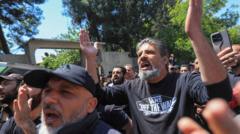In a recent episode of violence, 100 individuals lost their lives in sectarian clashes in southern Damascus, reigniting concerns for the Druze community in a region marked by instability. The conflict reached a climax in April when Lama al-Hassanieh, a resident of Ashrafiyat Sahnaya, found herself in a bathroom as armed men roamed outside, shouting sectarian threats. As a unique religious minority with roots in Shia Islam, the Druze have historically navigated a complicated relationship with the Syrian state.
Under former President Bashar al-Assad, many Druze offered quiet loyalty to escape the sectarian violence that plagued other areas of Syria during the protracted civil war. They ventured into protests later in the conflict, banking on Assad's promises to safeguard minority rights. With the outcome of the war shifting toward Sunni extremist control, however, questions about their safety and integration into society are becoming more pronounced.
Not only have sectarian tensions worsened, but distrust in the very institutions meant to protect them has also escalated. A controversial audio recording allegedly featuring a Druze religious figure insulted Islam, sparking violence instigated against Druze individuals across Syria. According to the Syrian Observatory for Human Rights, at least 137 casualties resulted from the fallout, including Druze fighters and civilians.
Witness accounts of violence, such as those of university students caught in assaults on campus, paint a grim picture of their everyday existence. Many Druze students report feeling abandoned, not only by the state, which they believe failed to protect them, but also by society at large. The feeling of isolation is compounded by incidents of mockery from peers in response to their plight, deepening the urgency of their fears.
As the situation continues to evolve, some Druze are taking active measures to protect their communities. Yet, the overarching sentiment remains one of vulnerability in a country increasingly marked by sectarian divides. Trust in the government is tenuous at best, with many questioning the commitment to true representation and safety for all citizens.
The echoes of conflict linger in Ashrafiyat Sahnaya, leaving the Druze community grappling with loss, fear, and uncertainty about their place in Syria's future. While hope for peace persists, apprehension about increasing sectarianism continues to overshadow it.
Under former President Bashar al-Assad, many Druze offered quiet loyalty to escape the sectarian violence that plagued other areas of Syria during the protracted civil war. They ventured into protests later in the conflict, banking on Assad's promises to safeguard minority rights. With the outcome of the war shifting toward Sunni extremist control, however, questions about their safety and integration into society are becoming more pronounced.
Not only have sectarian tensions worsened, but distrust in the very institutions meant to protect them has also escalated. A controversial audio recording allegedly featuring a Druze religious figure insulted Islam, sparking violence instigated against Druze individuals across Syria. According to the Syrian Observatory for Human Rights, at least 137 casualties resulted from the fallout, including Druze fighters and civilians.
Witness accounts of violence, such as those of university students caught in assaults on campus, paint a grim picture of their everyday existence. Many Druze students report feeling abandoned, not only by the state, which they believe failed to protect them, but also by society at large. The feeling of isolation is compounded by incidents of mockery from peers in response to their plight, deepening the urgency of their fears.
As the situation continues to evolve, some Druze are taking active measures to protect their communities. Yet, the overarching sentiment remains one of vulnerability in a country increasingly marked by sectarian divides. Trust in the government is tenuous at best, with many questioning the commitment to true representation and safety for all citizens.
The echoes of conflict linger in Ashrafiyat Sahnaya, leaving the Druze community grappling with loss, fear, and uncertainty about their place in Syria's future. While hope for peace persists, apprehension about increasing sectarianism continues to overshadow it.




















